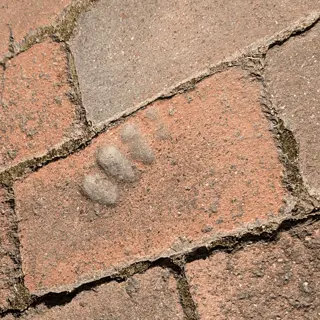
What is Left Behind: Builders at 6 National Trust Historic Sites Leave Their Mark
Every brick, every clapboard, every shingle on the buildings and structures across the United States was put in place by human beings whose labor and skills so often go unacknowledged. In many cases, particularly at former plantation homes, those materials were crafted by skilled enslaved people.
Hidden behind plasterwork, or on the surface of the brick, these individuals leave their marks through fingerprints or inscriptions that say to those who come across them decades or centuries later: “I was here. I made this.”
Read about these individuals and the marks they left behind at six National Trust Historic Sites.
Hotel de Paris Museum (Georgetown, Colorado)
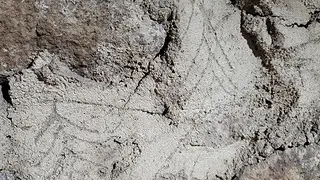
photo by: Hotel de Paris Museum
Inscriptions believed to have been left by Chinese laborers as they constructed the 1882 addition of Hotel de Paris.
Chinese laborers constructed most of Louis Dupuy’s Hotel de Paris. The 1882 addition (under construction when the United States passed the Chinese Exclusion Act) began with the demolition of a dwelling for an expansion that would include a cellar to house a boiler for steam heat. A tunnel leading from this area retains markings believed left by these workers. Scratched into mortar are designs resembling trees; in addition, there are places where workers’ fingers imprinted wet mortar, which later cured and preserved traces of their contributions in building one of the finest hotels West of the Mississippi River.
Woodlawn (Alexandria, Virginia)
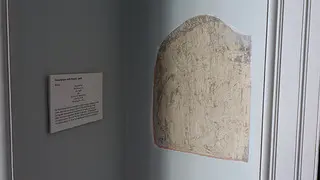
photo by: Woodlawn & Pope Leighey House
View of Joe Burneston's, a wallpaper craftsman, signature at Woodlawn.
Many people have left their mark on Woodlawn over the past 220 years. From the bricks to the wallpaper, physical reminders of their work remain. In the 18th and 19th centuries, bricks were made by hand through a process that involved mixing clay, sand, and water together.
At plantations like Woodlawn, this tedious and laborious work was typically done by enslaved workers. These bricks, located in the visitor pathway (as seen in the header image of the story), serve as a reminder of this unseen labor. In the early 20th century, Joe Burneston, a wallpaper craftsman, wrote his name on the wall of the southeast bedroom. His work was overseen by Woodlawn’s then-owner, Elizabeth Sharpe, who restored the house to its early 19th-century appearance.
Oatlands (Leesburg, Virgina)
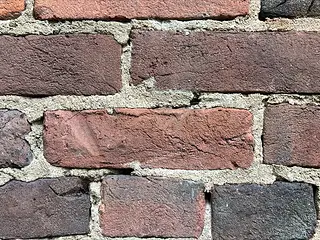
photo by: Oatlands
One of the fingerprint swipes on a brick at the dairy at Oatlands.
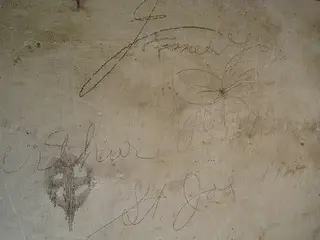
photo by: Oatlands
Signature of Arthur P. Murray, Oatlands' gardener, on the garden dependency wall.
In 1917, Oatlands Gardener Arthur P. Murray wrote his name on a garden dependency wall, beginning a tradition that has lasted for over a century. While we are unsure if he was the first to put pencil to plaster, many have followed since, with some including dates and others leaving doodles.
In 2013, through a National Trust Innovation Lab Grant, the wall was photographed and researched. While rarely seen, names, notes, and doodles speak to the close, complex relationship Oatlands’ caretakers have had with the gardens. They also pique our curiosity: while we know that enslaved workers made thousands of bricks on the property to build the mansion, dairy, meat house, garden dependency, and other brick buildings on the property, there are no marks or names of the enslaved who first created the gardens in the early 1800s…what did they think of the space?
Twentieth-century immigrant Alfredo Siani brought his own horticultural knowledge to the space. Do the gardens retain his impact? Indeed, the wall speaks to the fact that places are not created by one person, but many.
Brucemore (Cedar Rapids, Iowa)
Brucemore’s Lord and Burnham greenhouse was built in 1915. The Hall family added onto the building in 1940. When the concrete for the addition was poured, the Hall’s head gardener, David Hughes, left his initials. The initials W.M. are also visible, likely left by an assistant or another staff member.
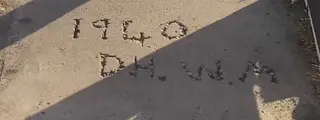
photo by: Brucemore
Initials of Brucemore's gardner, David Hughes, inscribed on concrete for the 1915 greenhouse.
President Lincoln’s Cottage (Washington, D.C.)
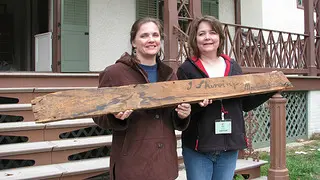
photo by: President Lincoln's Cottage
Two descendents of M. John Skirving holding the board on which he had inscribed his name at President Lincoln's Cottage.
The house that Lincoln resided in over the summers of 1862, 1863, and 1864 was originally constructed in 1842 when a Washington builder named William H. Degges submitted his “specifications of materials and workmanship, of a house to be built for Geo. W. Riggs on his farm near Rock Creek Church.” The specifications included a note about the construction of a “Verandah on south side according to plan giving by M John Skirving.”
During the interior restoration of the Cottage in 2006 and 2007, a board was discovered in the attic of the summer kitchen that read “J Skirving Washington DC For G Riggs” Just prior to the site’s opening in 2008, direct descendants of John Skirving where invited to stand in front of the verandah that their distant relative had designed one hundred and sixty six years prior and place their hands on the board baring his name.
Drayton Hall (Charleston, South Carolina)
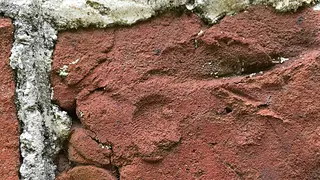
photo by: Drayton Hall
Fingerprint on one of the bricks at Drayton Hall.
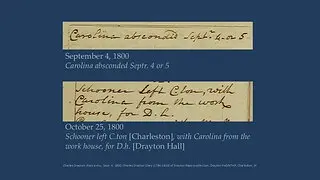
Image and transcription of two entries in Charles Drayton I diary about Carolina Bricklayer.
The bricks at Drayton Hall predate both the American Revolutionary War and the American Civil War, with some made as early as the 1680s. Most of the 366,000 bricks used to build Drayton Hall were handmade by people enslaved by John Drayton. We remember Carolina Bricklayer, whose determination to be free was matched by his skill as a mason. Carolina, a leader in Drayton Hall’s enslaved community, lived on the plantation with his son, Peter. Their hands helped build a world they were not free to live in. These excerpts from Charles Drayton I’s 1800 diary reveal Carolina’s second attempt at freedom. Though he was captured and punished in the Charleston Workhouse, Carolina didn’t give up—he tried at least 8 times to escape slavery, risking his life for freedom.
Carolina did
not see the abolishment of slavery in his lifetime, but his resistance
mattered, his story endures, and his courage inspires.
Contributions were provided by Kevin Kuharic, executive director at Hotel de Paris; Elizabeth Reese senior manager of public programs and interpretation at Woodlawn & Pope-Leighey House; Lori Kimball, senior manager of programs.at Oatlands; Jennifer Beall the events and communications coordinator at Brucemore; and Rebecca Kilbourne, senior marketing & communications manager at President Lincoln’s Cottage, and Patty Sailor, communications & marketing manager at Drayton Hall.
Donate Today to Help Save the Places Where Our History Happened.
Donate to the National Trust for Historic Preservation today and you'll help preserve places that tell our stories, reflect our culture, and shape our shared American experience.



